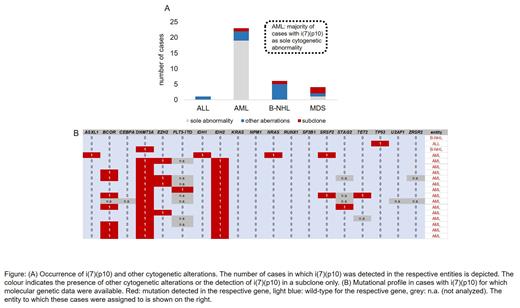Background: The chromosomal alteration i(7)(p10) is a rare abnormality in hematological malignancies. It leads to a loss of the long arm (7q) and duplication of the short arm (7p) of chromosome 7. However, the presence, frequency and clinical implications of i(7)(p10) in hematological neoplasms has not been analyzed systematically to date.
Aim: (1) Analysis of the frequencyand occurrence of i(7)(p10) in hematological malignancies. (2) Characterization of additional cytogenetic alterations and co-occurring mutations. (3) Analysis of potential clinical implications.
Patients and methods: All samples sent for diagnosis of suspected hematologic neoplasms between 08/2005 - 05/2023 were used for detection of i(7)(p10). Presence of i(7)(p10) was analyzed using chromosome banding analysis (CBA). In cases with available molecular genetic analyses the following genes were analyzed: ASXL1, BCOR, CEBPA, DNMT3A, EZH2, FLT3-ITD, IDH1, IDH2, KRAS, NPM1, NRAS, RUNX1, SF3B1, SRSF2, STAG2, TET2, TP53, U2AF1 and ZRSR2. Variants of unknown significance were excluded from statistical analysis. All reported p-values are two-sided and were considered significant at p<0.05.
Results: In 34 cases an i(7)(p10) was detected. Regarding specific entities, i(7)(p10) was mainly found in AML (23/34, 68%) and rarely in other entities (mature B-cell neoplasms (B-NHL): 6/34, 18%; MDS: 4/34, 12%; ALL: 1/34, 3%). In 20/34 cases, i(7)(p10) comprised the sole cytogenetic abnormality, including 19 AML cases and 1 MDS case. In 10/34 cases, additional chromosomal alterations were detected, leading to a complex karyotype in 5 of these cases. Of note, all cases with a complex karyotype were B-NHL. Additionally, in 4 cases i(7)(p10) was present only in a subclone (1 AML, 1 B-NHL, 2 MDS cases) (Figure A). In 18/34 cases, molecular genetic data was available, revealing DNMT3A (15/18), IDH2 (14/18) and BCOR (7/18) as most frequently mutated genes. As these 18 cases comprised n=15 cases diagnosed as AML, further analysis focused on these patients only. 14/15 cases harbored a mutation in IDH2, the remaining case showed an IDH1 mutation. Further, in 14/15, 7/15 and 4/15 cases, mutations in DNMT3A, BCOR and EZH2 were detected, respectively. By contrast, mutations that are known to frequently co-occur with IDH2 mutations in AML ( SRSF2, ASXL1, NPM1, STAG2, RUNX1, NRAS) were absent or only very rarely detected (Figure B). 12/14 cases with IDH2 mutations showed the mutation site p.Arg172Lys, 2/14 cases p.Arg140Leu, which is known to be the most frequent IDH2 mutation site. This is corroborated by analysis of a control cohort of n=60 IDH2 mutated AML cases without i(7)(p10), in which only 8/60 cases with p.Arg172Lys were detected (86% vs. 13%, p<0.001). Further, comparison of variant allele frequency (VAF) of IDH2 with the VAF of co-mutations suggested the presence of IDH2 in the main clone of all cases, although IDH2 VAF of cases with i(7)(p10) was slightly but not significantly lower than the IDH2 VAF of AML cases without i(7)(p10) (38.3 vs. 45.9). Moreover, comparison of IDH2 mutated AML with and without i(7)(p10) revealed a predominance of females (13/14, 93% vs. 29/60, 48%, p<0.001) and of younger age (63 vs. 72 years, p=0.015) in cases with i(7)(p10). Analysis of overall survival (OS) did not reveal a significant difference between IDH2 mutated AML cases with and without i(7)(p10), although cases with i(7)(p10) showed a trend towards a better outcome (37 vs. 14 months).
Conclusions: (1) The rare but recurrent cytogenetic aberration i(7)(p10) is mainly found in AML, where associations with mutations in IDH2, DNMT3A and BCOR were observed. By contrast, other AML-defining mutations ( NPM1, FLT3-ITD, CEPBA) were largely absent, further no defining fusions/rearrangements or a complex karyotype were detected. (2) The vast majority of patients were female and younger than patients with IDH2 mutation without i(7)(p10). (3) Almost all cases showed the rare hotspot p.Arg172Lys and i(7)(p10) as sole aberration, thus it can be speculated that these cases define a distinct subgroup. (4) OS seems to be slightly better than in IDH2 mutated AML without i(7)(p10), although this difference was not statistically significant. (5) Taking into account that the IDH2 mutation was always detected in the main clone and that no other targetable genes/aberrations were observed, these patients are potentially suitable for targeted therapy with IDH inhibitors.
Disclosures
Stengel:MLL Munich Leukemia Laboratory: Current Employment. Meggendorfer:MLL Munich Leukemia Laboratory: Current Employment. Baer:MLL Munich Leukemia Laboratory: Current Employment. Hutter:MLL Munich Leukemia Laboratory: Current Employment. Kern:MLL Munich Leukemia Laboratory: Current Employment, Other: Equity Ownership. Haferlach:MLL Munich Leukemia Laboratory: Current Employment, Other: Equity Ownership. Haferlach:MLL Munich Leukemia Laboratory: Current Employment, Other: Equity Ownership.


